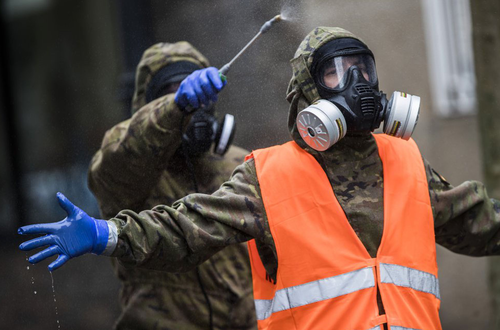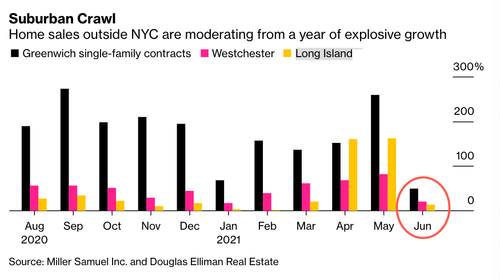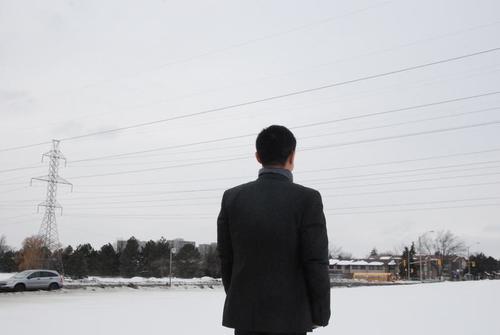In 2019, Department of Homeland Security Agent Ray Lamb was arrested for aggravated assault with a deadly weapon and misdemeanor criminal mischief. He’d had an altercation in a Conroe, Texas, restaurant parking lot with Kevin Byrd, the ex-boyfriend of Lamb’s son’s girlfriend. According to Byrd, Lamb threatened him with a gun and tried to smash the window of his car. After Byrd called the cops for help, Lamb pulled out his federal badge, which led the officers to handcuff Byrd and detain him for several hours. It was only after the police reviewed the security camera footage that Byrd was released and Lamb finally placed under arrest.
Byrd sued Lamb over the incident, but in March 2021 the U.S. Court of Appeals for the 5th Circuit flatly dismissed his civil rights lawsuit. Why? According to one member of the court, its hands were tied.
“Middle-management circuit judges must salute smartly and follow precedent,” Judge Don Willett regretfully explained in his concurring opinion. “And today’s result is precedentially inescapable: Private citizens who are brutalized—even killed—by rogue federal officers can find little solace” in U.S. Supreme Court case law. The unfortunate reality, Willett observed, is that “if you wear a federal badge, you can inflict excessive force on someone with little fear of liability.”
Vindicating your rights in court is a cornerstone of the rule of law. As the famous British jurist William Blackstone observed, “in vain would rights be declared, in vain directed to be observed, if there were no method of recovering and asserting those rights, when wrongfully withheld or invaded.”
Blackstone’s dire scenario resembles what is happening in the United States today in cases like Byrd v. Lamb. File suit for damages against a lawless federal officer, and the federal courts likely will toss the suit in the name of following precedent. As Willett noted in his judicial protest, “redress for a federal officer’s unconstitutional acts is either extremely limited or wholly nonexistent, allowing federal officials to operate in something resembling a Constitution-free zone.”
How did this sorry state of affairs come to pass?
‘A “Disfavored” Judicial Activity’
In 1967, a Brooklyn man named Webster Bivens sued a group of federal narcotics agents in federal court for busting into his apartment without a warrant, ransacking the place, shackling him in front of his family, and later strip-searching him at the federal courthouse. Bivens won.
“That damages may be obtained for injuries consequent upon a violation of the Fourth Amendment by federal officials should hardly seem a surprising proposition,” observed Justice William Brennan in the 1971 case Bivens v. Six Unknown Named Agents of the Federal Bureau of Narcotics. “Historically, damages have been regarded as the ordinary remedy for an invasion of personal interests in liberty.” In other words, federal officers can be held civilly liable for conduct that violates constitutional rights. Lawyers call this sort of legal action a “Bivens claim.”
Eight years later, in Davis v. Passman (1979), the Supreme Court sustained a Bivens claim filed by a former congressional staffer who alleged workplace sex discrimination in violation of the Fifth Amendment’s Due Process Clause. A year after that, in Carlson v. Green, the Court permitted an Eighth Amendment Bivens claim filed by the estate of a federal prisoner against his captors, alleging that they contributed to his death by denying him medical treatment.
Alas, it has been downhill for Bivens ever since. In subsequent decades, the Supreme Court not only refused to recognize any new Bivens claims; it did practically everything in its power to neutralize the decision short of overruling it outright.
Consider the Court’s 2017 decision in Ziglar v. Abbasi. The case involved several detainees held in the wake of the September 11, 2001, terrorist attacks who alleged abusive treatment. Citing national security concerns, the Supreme Court readily dismissed their Bivens claims against various federal officials, including former Immigration and Naturalization Service Commissioner James Ziglar. At the same time, the Court made it clear that future Bivens plaintiffs would have to clear a very high bar before getting their own days in court.
If a Bivens claim arises in a “new context,” meaning “the case is different in a meaningful way from previous Bivens cases decided by this Court,” Justice Anthony Kennedy wrote, the presiding judge must scour the record for any “special factors counselling hesitation.” For example, Kennedy said, “the risk of personal damages liability is more likely to cause an officer to second-guess difficult but necessary decisions concerning national security policy.” If any such “special factor” is found (or simply invented by the judge), the lawsuit against the federal officer must be dismissed.
Three years later, in Hernandez v. Mesa (2020), the Court reaffirmed its hostility toward Bivens plaintiffs. “If we have reason to pause before applying Bivens in a new context or to a new class of defendants,” wrote Justice Samuel Alito, “we reject the request.” In short, as Kennedy put it in Ziglar, “the Bivens remedy is now a ‘disfavored’ judicial activity.”
The lower courts got the message. In Oliva v. Nivar (2020), the 5th Circuit dismissed a Bivens claim by 70-year-old José Oliva, a Vietnam veteran who was beaten and permanently injured by federal police at a Department of Veterans Affairs hospital in El Paso, Texas. According to Oliva, the officers took a disliking to him because he did not immediately show his ID, which was momentarily out of his reach in a metal detector bin. He also spoke up against their verbal bullying. “I got a problem with this man,” one of the officers reportedly said about Oliva’s lack of deference. “He’s got an attitude.” The same officer placed Oliva in a chokehold and slammed him to the ground, severely injuring his shoulder.
The 5th Circuit characterized Oliva’s civil rights lawsuit as a “new context,” which is basically the kiss of death for Bivens claims. Yes, the court admitted, both Oliva and Bivens centered on allegations of Fourth Amendment violations by federal officers. But “this case differs from Bivens in several meaningful ways.” For one, “the case arose in a government hospital, not a private home.” For another, “the VA officers were manning a metal detector, not making a warrantless search for narcotics.” From there it was all too easy for the 5th Circuit to find “special factors counselling hesitation,” such as the fact that Congress specifically “did not make individual officers liable for excessive-force claims.”
In sum, thanks to SCOTUS-sanctioned legal hairsplitting, a victim of abusive federal policing did not even get a chance to make his case for damages.
‘Merited Punishment’
Bivens became “a ‘disfavored’ judicial activity” because a majority of the Supreme Court has come to see it as an example of judicial activism, a modern ruling that empowered federal judges to do something they should not do. The late Justice Antonin Scalia called Bivens “a relic of the heady days in which this Court assumed common-law powers to create causes of action.” Justice Clarence Thomas has argued that “the analysis underlying Bivens cannot be defended.”
But was Bivens really such a radical departure? Not when considered in the full light of American legal history. Indeed, the idea that federal judges have the authority to impose damages against lawless federal officers is as old as the republic—older, in fact, since it comes from venerable British common law judgments that directly influenced the founding generation.
In Entick v. Carrington (1765), for example, the chief justice of Britain’s Court of Common Pleas, Lord Camden, weighed a suit for damages filed by the Grub Street journalist John Entick against three messengers of King George III. The messengers, acting on a general warrant issued by the secretary of state, Lord Halifax, broke into Entick’s home by force of arms, destructively rifled his belongings, and carried away various papers and effects.
It is “incumbent upon the defendants to show the law by which this seizure is warranted,” Camden declared in his judgment. “If that cannot be done, it is a trespass,” and the king’s messengers are “liable to an action.” In what is now remembered as one of the great early victories for civil liberty against overreaching government power, Camden ruled the defendants liable because the general warrant they acted under “is not law.”
That ruling heavily influenced what would become the Fourth Amendment to the U.S. Constitution. And it is no wonder that it did. As Yale legal scholar Akhil Reed Amar noted in his book The Bill of Rights, Entick v. Carrington was “one of the two or three most important search-and-seizure cases on the books in 1789.”
America’s founding generation was deeply committed to seeing the judiciary hold wayward federal officers civilly liable for their misdeeds. That commitment is readily apparent when you examine the debates over the ratification of the Constitution, in which both sides subscribed to this particular view of the judicial role.
In 1788, for instance, the Anti-Federalist writer known as Maryland Farmer argued that “whenever an officer had deviated from the rigid letter of the law,” that officer should be forced to pay “ruinous damages.” But under the proposed Constitution, Maryland Farmer feared, federal judges might refuse to award damages to “spare the public purse, if not favour a brother officer.”
George Mason, another Anti-Federalist, raised the same concern at the Virginia ratifying convention. Speaking on June 19, 1788, Mason worried that the new federal judiciary could not be trusted “to bring officers to justice.” Suppose “any of the federal officers should be guilty of the greatest oppressions, or behave with the most insolent and wanton brutality to a man’s wife or daughter,” Mason demanded, “where is this man to get relief?”
Federalist John Marshall, the future chief justice of the United States, responded to Mason the next day. Mason “says that the officers of the government will be screened from merited punishment by the federal judiciary,” Marshall said. “The federal sheriff, [Mason] says, will go into a poor man’s house and beat him, or abuse his family, and the federal court will protect him.”
Nonsense, Marshall declared. “Will such great insults on the people of this country be allowable?” he asked. “Were a law made to authorize them, it would be void. The injured man would trust to a [judicial] tribunal in his neighborhood. To such a tribunal he would apply for redress, and get it.”
Marshall proved as good as his word while serving as chief justice. In Little v. Barreme (1804), he led the Supreme Court in finding a U.S. naval officer liable for trespass after he seized a ship based on an illegitimate presidential order. “The law must take its course,” Marshall wrote, “and he must pay such damages as are legally awarded against him.” Likewise, in Wise v. Withers (1806), Marshall found a District of Columbia justice of the peace liable for trespass after the officer entered a man’s home without legal authority.
Such rulings against rogue federal officers continued to appear in subsequent decades. “At the Founding, and for much of American history, there was no question as to whether federal courts had the power to provide judge-made damages remedies against individual federal officers,” observed University of Texas law professor Stephen Vladeck in the Cato Supreme Court Review: 2019–2020. “Not only did federal courts routinely provide such relief, but the Supreme Court repeatedly blessed the practice.” The Bivens case—in which federal drug cops were held civilly liable for unconstitutional search and seizure—is consistent with this noble legal tradition.
‘Precluded’
In the last few decades, just as the Supreme Court was whittling away at Bivens, Congress found a way to make matters worse. Under the Federal Employees Liability Reform and Tort Compensation Act of 1988, any nonfederal “civil action or proceeding for money damages” filed against a federal employee “acting within the scope of his office or employment…is precluded.” In other words, that law, also known as the Westfall Act, prohibited plaintiffs from filing state common law suits against federal officers.
Traditionally, rights-violating federal officers were often sued in state court for committing state common law offenses, although a case might be removed to federal court if it raised a federal question. Webster Bivens could have sued the federal drug cops who victimized him in state court for trespass and false imprisonment, an option that the Court acknowledged.
The Westfall Act took that option off the table, leaving the next Webster Bivens with no choice but to file a federal Bivens claim. Meanwhile, the Supreme Court has undermined Bivens to such an extent that the ruling is practically a dead letter. Now that a Bivens claim is the only remaining option for plaintiffs seeking to sue rogue federal officers, most of those plaintiffs have been left with no real recourse at all. The courthouse doors—state and federal—are effectively closed against them.
But there are a few ways this problem could be ameliorated.The Supreme Court could put some teeth back into Bivens. The case of José Oliva, the 70-year-old Vietnam vet beaten by V.A. cops, illustrates how it might happen. Recall that the 5th Circuit, taking its marching orders from SCOTUS, dismissed Oliva’s lawsuit as a “new context,” with that claim hinging on the distinction between officers working security at a V.A. hospital and officers conducting a warrantless search for drugs in an apartment as in Bivens. Why not ditch that hyper-specific test and just say that any lawsuit plausibly alleging Fourth Amendment violations should be allowed to proceed?
Regrettably, the current Supreme Court seems unlikely to take that approach.
Congress could do its part by revising the Westfall Act to once again allow state common law suits against perfidious federal officers. Congress also could codify Bivens-type remedies by passing a statute that specifically allows such suits in federal court.
Whatever the solution, it is long past time for the many victims of rights-violating federal officers to start getting some redress in court.

from Latest – Reason.com https://ift.tt/2SPUzcy
via IFTTT















